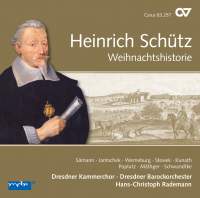Texte paru dans: / Appeared in: |
|
|
Outil de traduction ~ (Très approximatif) |
|
|
Reviewer: James
A. Altena This latest entry in the complete Schütz edition being issued by Carus was warmly greeted by my colleague J. F. Weber in 38:4, a welcome I fully second. The Weihnachtshistorie (Christmas Story)—or, to give its very long-winded full official title, Historia der freuden- und gnadenreichen Geburth Gottes und Marien Sohn, Jesu Christi, unsers einigen Mittlers, Erlösers und Seeligmachers (Story of the joyful and gracious Birth of God’s and Mary’s Son, Jesus Christ, our own Mediator, Redeemer, and Savior)—is one of Schütz’s last compositions. It was first performed in 1660 when the composer was 75 years old, but the first official edition was printed four years later. Except for the introduction and final chorus of thanksgiving, the text is taken from the nativity narratives in Luke 2:1–21 and Matthew 2:1–23, sequentially arranged and rounded off by Luke 2:40. The chief part is that of the evangelist, a solo tenor; in eight Intermedia passages, there are solo roles for an angel (soprano) and for Herod (bass), plus choral ensembles for the host of angels, shepherds, chief priests and scribes, and the Magi. The evangelist’s recitatives are sparsely accompanied by organ, theorbo, and violone, with the larger instrumental ensemble (including violins, gambas, recorders, cornetts, trombones, and dulcian) reserved for the ariosos and choruses. In addition to the two chief soloists (soprano and tenor), the choristers and instrumentalists participating in this production number 18 apiece. The Weihnachtshistorie is easily the most often recorded work by Schütz; there are currently about 15 different versions available, and several more out of print. (I first learned the piece from the 1963 Angel/EMI recording led by Hans Thamm, with the young Edith Mathis singing the solo soprano part.) Such names to conjure with as Frieder Bernius, Paul Hillier, René Jacobs, Sigiswald Kuijken, Paul McCreesh, and Andrew Parrott, plus a joint effort by William Ehmann and Helmut Rilling, are represented in the active discography. Among those, the version by Hillier on DaCapo, endorsed by Weber in 33:5 and by me in 35:4, occupies a very special rank of excellence; after that I would cite as preferred versions Bernius on Sony and two lesser-known names, Michel Laplenie on Accord and Wolfgang Katschner on Berlin. Rademann’s new version here can proudly assume a place alongside these, with his typically astute leadership and an excellent solo trio in Gerlinde Sämann, Georg Poplutz, and Felix Schwandtke. The disc is filled out by five sacred motets with texts related to the Nativity. Two of these, the Magnificat, SWV 468 (1665)—one of four settings of the text by Schütz, but the only one to use a Latin rather than German text—and O bone Jesu, SWV 471 (1666), are among the composer’s most frequently recorded shorter works, with a dozen or so recordings each. Heute ist Christus, der Herr, geboren, SWV 439, dates from somewhere between 1632 and 1638. Hodie Christus natus est, SWV 456, was once dated c. 1610 to Schütz’s early years in Venice as a pupil of Giovanni Gabrieli, but some scholars have more recently placed it to some time in the 1640s. I could not locate any information regarding a likely date of composition for Ach Herr, du Schöpfer aller Ding, SWV 450, but its use of madrigal form suggests an early one by association with the composer’s op. l set of Italian secular madrigals. A setting of a strophe by Martin Luther that reflects upon the lowliness of the circumstances of Christ’s birth, its somber musical tone stands in striking contrast to the meditative but more optimistic O bone Jesu and the unabashedly exultant strains of the other three sacred concertos. As before, Carus provides detailed bilingual booklet notes, full texts, bios of all the performers, and rich, somewhat reverberant recorded sound. Those who, along with me, are acquiring successive releases in this series should not hesitate; strongly recommended. If only the long-awaited Becker Psalter would next appear! | |
|
|
|
|
Cliquez l'un ou l'autre
bouton pour découvrir bien d'autres critiques de CD |
|




